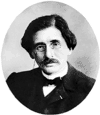
May 10, 2013, by Brigitte Nerlich
Gabriel Tarde and science communication – some reflections
More than a century ago the French sociologist Gabriel Tarde began to think seriously about knowledge, influence, politics and publics (Tarde, 1895, 1898, 1903; see here). Most importantly, he wanted to study the dynamics of interaction between various actors in networks of ‘conversation’ (Nerlich, 1992, 1996) (Clark, 1969, Katz, 1993, Katz, 2006).
Communication, opinion, power and influence
In this post I make the claim that it might be a good idea to use some of Tarde’s ideas to inspire scholarship into science communication from a sociological perspective, a perspective that has largely been absent from studies of science communication or reflections on the various practices of science communication. By science communication I mean the communicative activities undertaken by scientists, historians of science, communication professionals, outreach or engagement specialists, educators, researchers or intermediaries of any kind, in a variety of social spheres from universities, to market squares, to the corridors of power.
Tarde tried to investigate how public opinion is formed and how it dissipates upwards and downwards in ‘public space’, from elites to everybody and from everybody to powerful political institutions. In between he situated newspapers, salons, coffee houses and conversations. In contemporary societies we still have publics and power, but salons and coffee houses are increasingly being replaced by the virtual worlds of blogs, internet forums, wikis, twitter, facebook, and so on.
Social and natural scientists, journalists, politicians, communicators, intermediaries and members of the general public now use a variety of online, offline and interpersonal forms of communication to disseminate news, knowledge and opinions, interact with each other, and ultimately influence politics and power. These new forms of communicative exchange have also had impacts on the older powers held by publics, newspapers, scientists and politicians. These shifts in who has the power to communicate, to influence and shape opinion and politics need to be investigated in more sociological detail.
A new sociology of science communication (related to but also different from the sociology of science and the study of science communication as an academic discipline) could examine ‘patterns of diffusion’ and influence that emerge from a variety of forms of interaction. These forms of interaction and communication (including conversation) span the formal and the informal, with the formal including both public engagement projects in which scientists and publics are enrolled and policy advice where scientific evidence (both natural and social) is sought but also contested, ignored or overruled by political decision makers and publics.
Tarde revisited
Over the last 15 years there has been a certain revival of interest in Tarde’s ideas, in philosophy and media theory (Peter Sloterdijk), Science and Technology Studies (Laet and Mol, 2000; Latour, 2001), sociology of work, political geography, etc; and there are even some people who study twitter, blogs and influence looking back at Tarde.
Bruno Latour (2010) “suggests that Tarde is an intellectual precursor to Actor Network Theory (ANT), which does not give ontological priority to either individuals or social wholes”. Latour also claims Tarde as a precursor to the study of networked societies, where data visualisation, and a host of other ‘datascapes’ mediate between people, policies, discoveries, innovations and so on. He points out that “[t]oday we can look at social data at a full range of levels of aggregation, moving back and forth from the micro to the macro with ease” and quotes from Tarde’s Laws of Imitation (1962; first published in French in 1890):
“If Statistics continues to progress as it has done for several years, if the information which it gives us continues to gain in accuracy, in dispatch, in bulk, and in regularity, a time may come when upon the accomplishment of every social event a figure will at once issue forth automatically, so to speak, to take its place on the statistical registers that will be continuously communicated to the public and spread abroad pictorially by the daily press.”
Conversation!
We have now reached this vision of the future! However, it has opened up a whole new suite of problems around access, accessibility, comprehensibility, and of course bureaucracy. These issues pose challenges to communication in general and science communication in particular that are beginning to be investigated and need further sociological thought.
To conclude this post, I want to come back to what Tarde said about conversation. Tarde understood by conversation “dialogue that has no direct or immediate utility, where one talks because one wants to talk, for pleasure, play or out of politeness. This definition excludes from our topic legal interrogations, diplomatic or commercial negotiations, as well as council meetings and even scientific congresses, despite the fact that they abound in superfluous chattering… There is nothing more grotesque … than the obligation, imposed by bureaucratic decree or any other particular rule, of arranging periodic meetings during which, sitting around a table, one is forced for half an hour or an hour, to torture one’s mind in order to say nothing to each other or else to say something one doesn’t think while at the same time not saying what one thinks.” (Tarde, Opinion and Conversation, 1898; transl. BN)
Conversation, be it off-line or on-line may still be the best vehicle for science communication and we should ideally make more space for it wherever we can. However, there is an increasing threat that this open space may be captured by ‘bureaucratic decree’ and that conversations may just be seen as useful tools to exert power and influence over opinion and policy. The real danger is that utility will trump pleasure.

[…] RT @peterbroks: Danger that open space of science conversations become bureaucratic tools to exert power – great post from @BNerlich http://t.co/4DgCitB3ZT […]
[…] Gabriel Tarde and science communication some reflections – 2013/05/10 […]